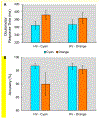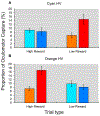Selection history is relative
- PMID: 32663647
- PMCID: PMC7484361
- DOI: 10.1016/j.visres.2020.06.004
Selection history is relative
Abstract
Visual attention can be tuned to specific features to aid in visual search. The way in which these search strategies are established and maintained is flexible, reflecting goal-directed attentional control, but can exert a persistent effect on selection that remains even when these strategies are no longer advantageous, reflecting an attentional bias driven by selection history. Apart from feature-specific search, recent studies have shown that attention can be tuned to target-nontarget relationships. Here we tested whether a relational search strategy continues to bias attention in a subsequent task, where the relationally better color and former target color both serve as distractors (Experiment 1) or as potential targets (Experiment 2). We demonstrate that a relational bias can persist in a subsequent task in which color serves as a task-irrelevant feature, both impairing and facilitating visual search performance. Our findings extend our understanding of the relational account of attentional control and the nature of selection history effects on attention.
Keywords: Attentional capture; Feature-based attention; Selection history.
Copyright © 2020 Elsevier Ltd. All rights reserved.
Figures






References
-
- Anderson BA (2016). The attention habit: How reward learning shapes attentional selection. Annals of the New York Academy of Sciences, 1369, 24–39. - PubMed
-
- Anderson BA, & Folk CL (2010). Variations in the magnitude of attentional capture:Testing a two-process model. Attention, Perception, & Psychophysics, 72, 342–352. - PubMed
Publication types
MeSH terms
Grants and funding
LinkOut - more resources
Full Text Sources

